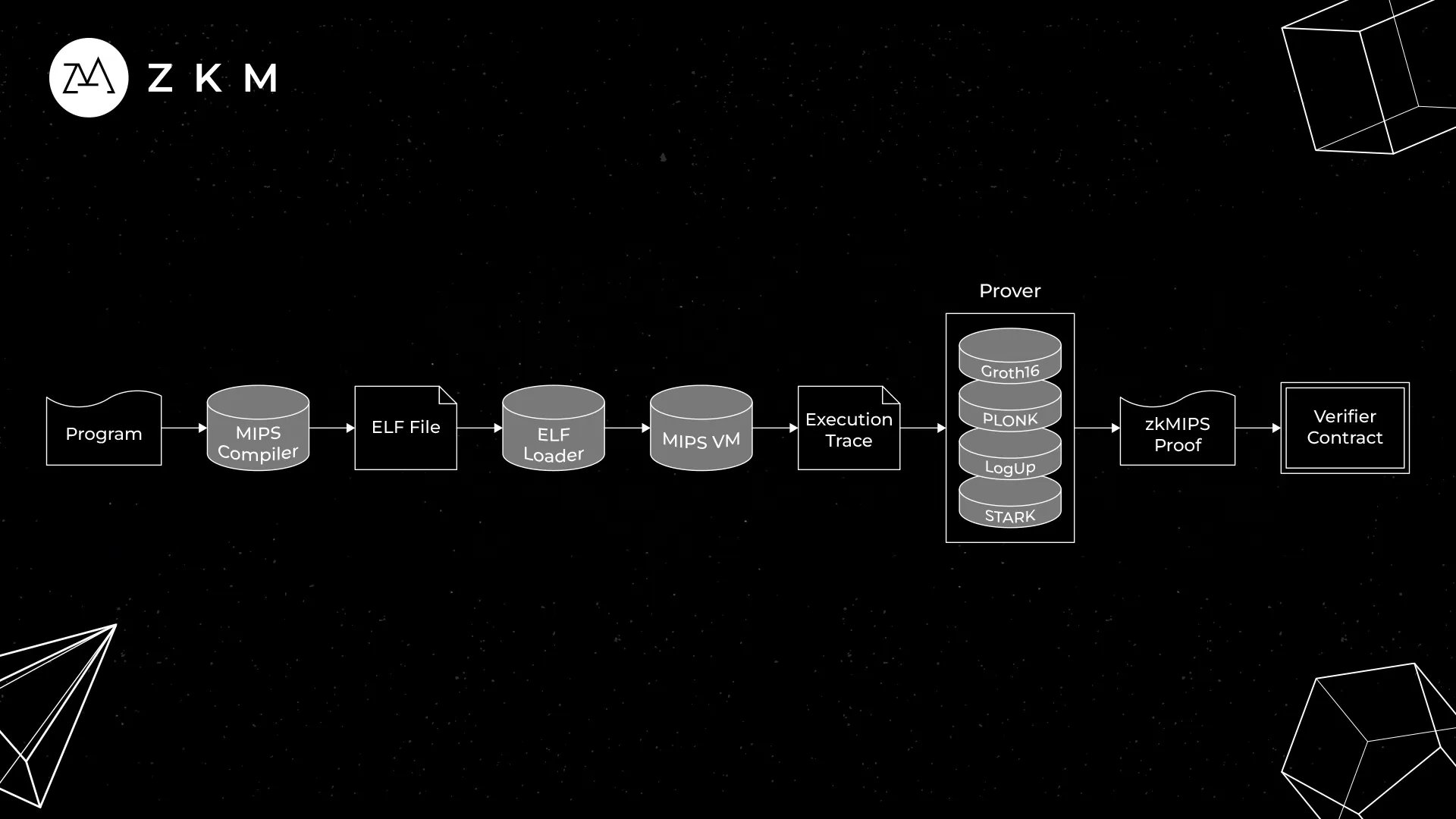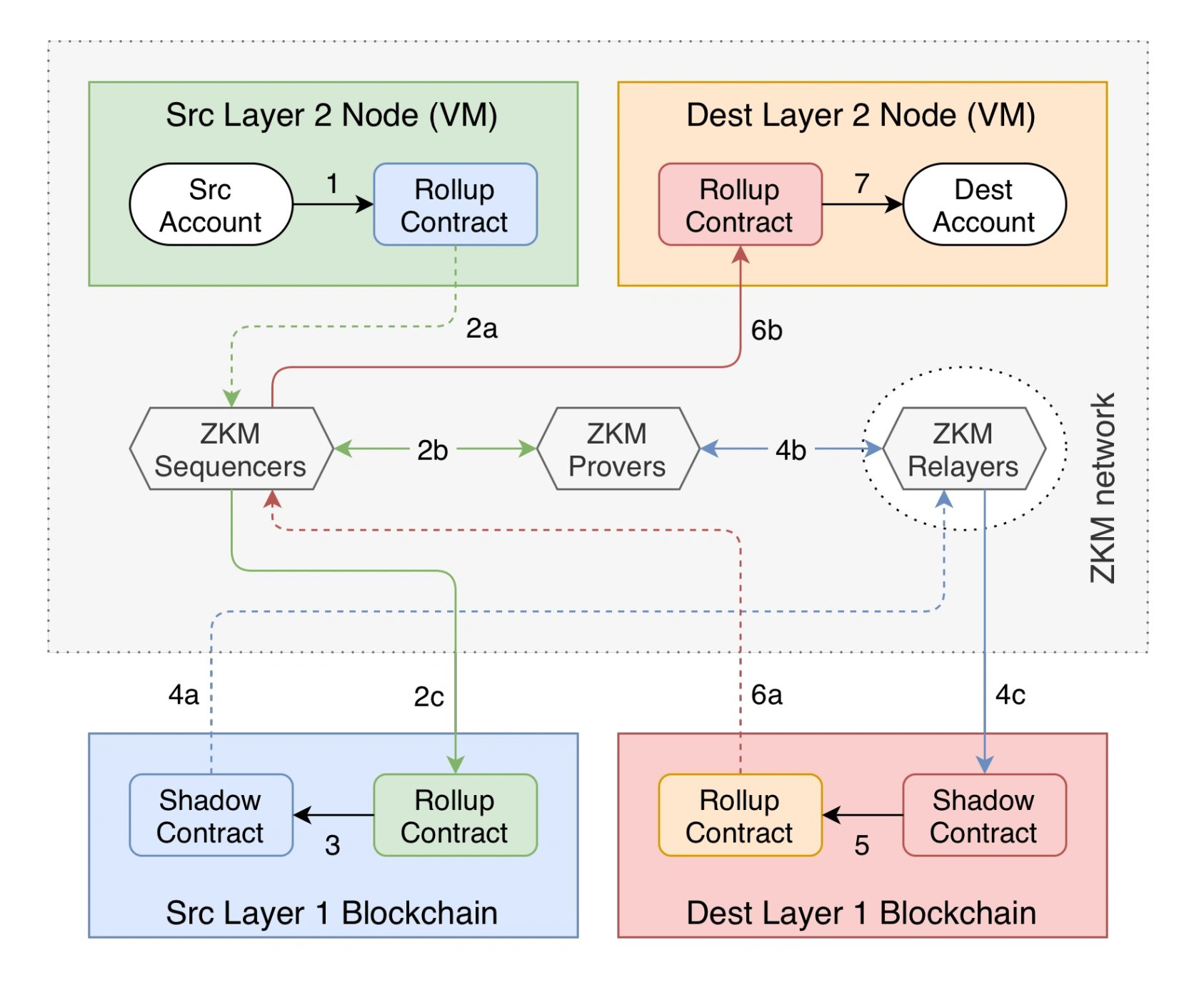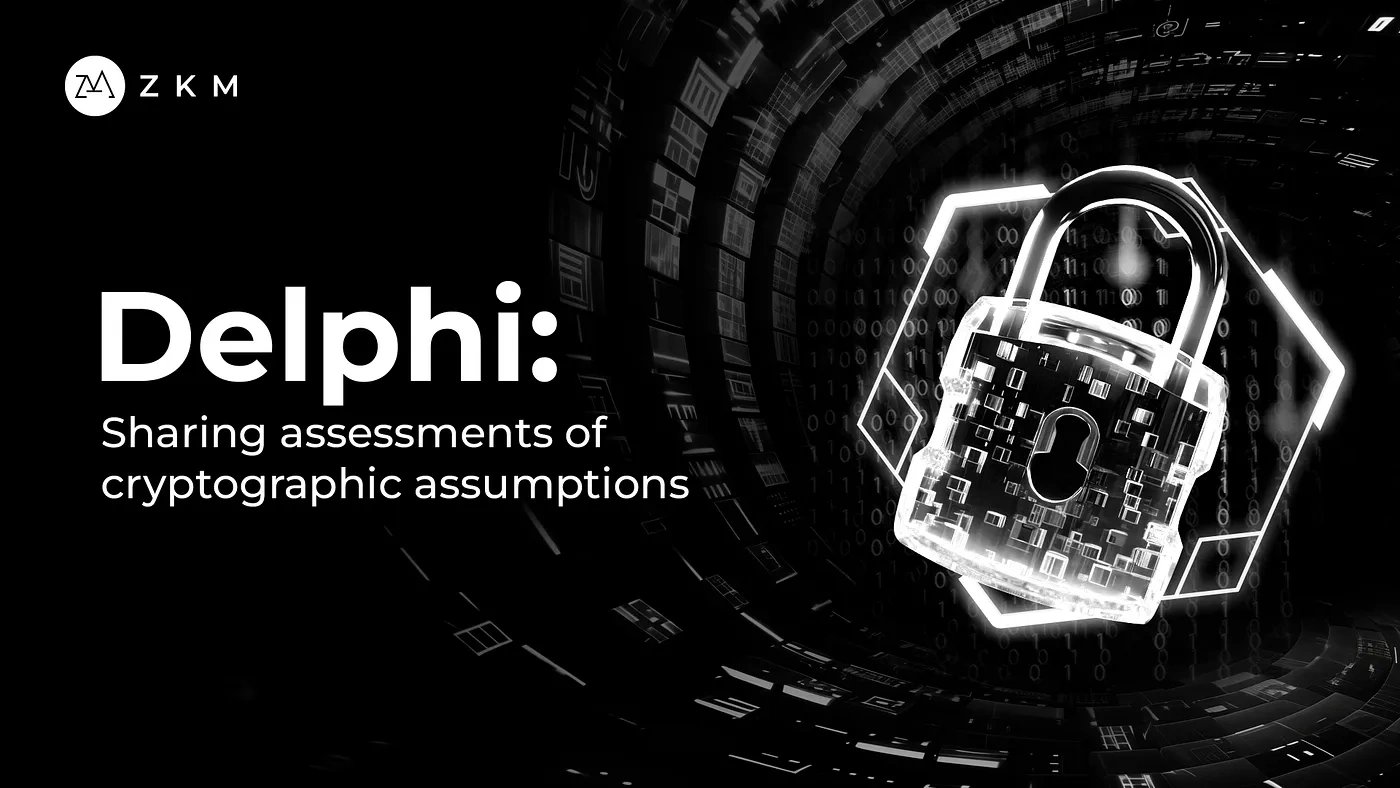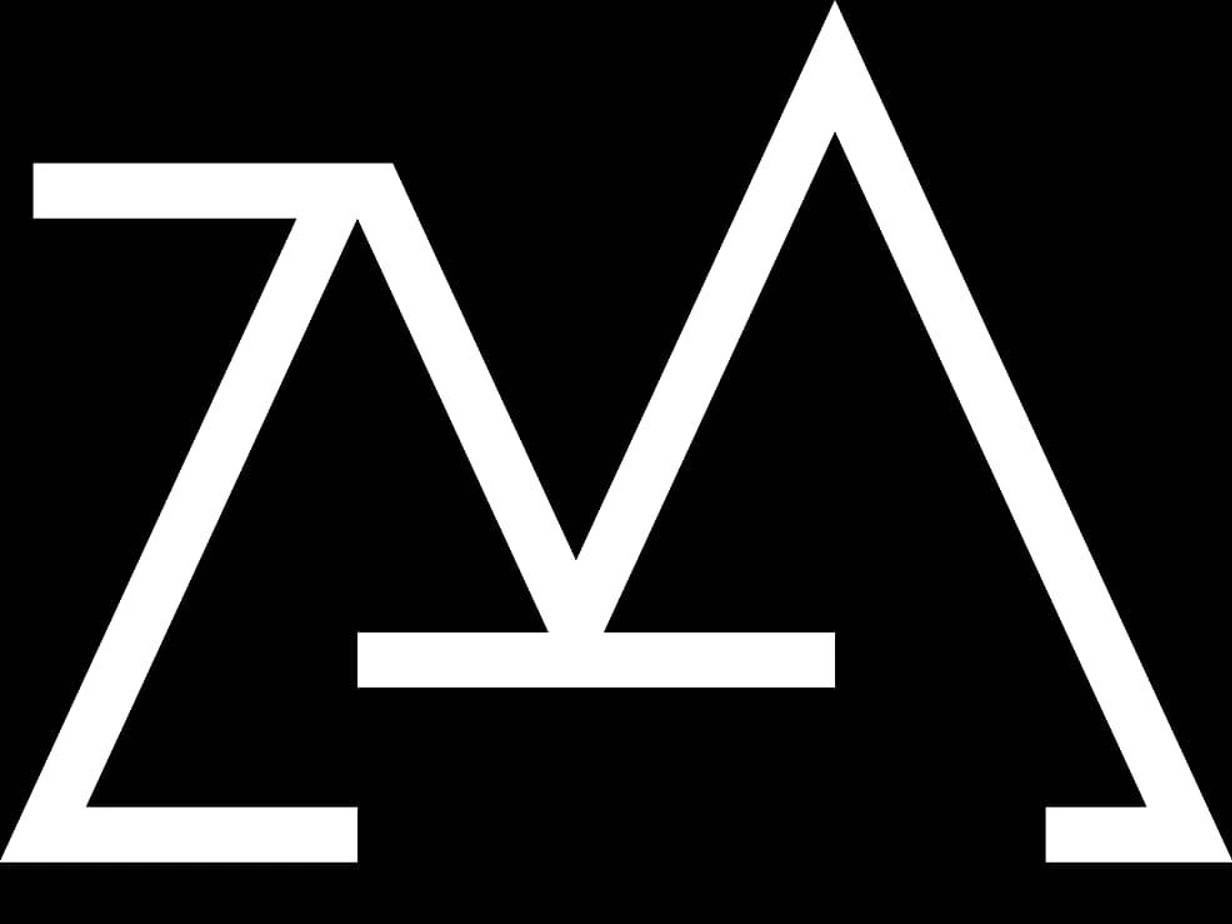위키 구독하기
Share wiki
Bookmark
ZKM
ZKM
**ZKM(제로-지식 MIPS)**는 축소 명령어 집합 컴퓨터(RISC) CPU 아키텍처의 한 유형인 MIPS(Microprocessor without Interlocked Pipeline Stages)와 제로-지식 증명(ZKPs)을 결합한 고급 아키텍처로, 상호 운용성을 향상시키고 분산 시스템을 통합하여 블록체인 공간의 분열 문제를 해결하는 것을 목표로 합니다. [1][2]
개요
ZKM은 MIPS 명령어 집합을 사용하는 오픈소스 프로젝트입니다. 보다 통합적인 블록체인 경험을 위한 검증 가능한 컴퓨팅 개선을 위한 연구 중심 방식에 초점을 맞추고 있습니다. 이 프로젝트는 블록체인 공간의 단편화를 해결하기 위해 상호 운용성을 향상시키고 분산 시스템을 통합하고자 합니다. ZKM은 다양한 블록체인 인프라 및 궁극적으로는 비-블록체인 시스템과 통합하도록 설계된 범용 zkVM을 개발하고 있습니다. 이 통합은 체인 간 안전하고 분산된 상태 변경 통신을 가능하게 하며, 이는 블록체인 기술의 광범위한 채택에 매우 중요합니다. [1][3]
이 프로젝트는 7일 철회 기간 제거, 모든 Layer 2 (L2) 솔루션 및 대체 Layer 1 (Alt L1) 블록체인 네트워크에 대한 통합 보안 달성, 그리고 위변조 방지 사물 인터넷(IoT) 및 클라우드 컴퓨팅 구현 등 여러 가지 과제를 극복하고자 합니다. 목표는 더 빠르고 편리한 자금 인출을 가능하게 하고, 다양한 L2 및 Alt L1 플랫폼에서 표준화된 보안 프레임워크를 구축하며, IoT 기기 및 클라우드 컴퓨팅 시스템의 보안 및 무결성을 향상시키는 것입니다. [1][3]
건축
zkVM
ZKM은 다양한 계산 작업 전반에서 제로지식 증명(Zero-Knowledge Proofs, ZKPs)을 용이하게 하도록 설계된 제로지식 가상 머신(zkVM)을 개발하고 있습니다. 이는 블록체인, IoT 기기 및 기타 Web2 솔루션 간의 상호 운용성을 위한 검증 가능한 컴퓨팅을 가능하게 합니다. 여기에는 제로지식 기술을 MIPS 아키텍처와 통합하여 신뢰할 수 없는 컴퓨터의 계산 결과에 대한 신뢰를 보장하는 검증 가능한 컴퓨팅 시스템을 만드는 것이 포함됩니다. 생성된 제로지식 증명(ZKPs)는 이더리움(Ethereum)에 저장될 수 있으며, 이는 블록체인 및 비-블록체인 기술에 대한 기본적인 결제 계층으로 이더리움(Ethereum)을 사용하려는 ZKM의 비전과 일치합니다. [4][5]
zkVM은 계산을 실행하고 유효성과 결과를 검증하기 위한 ZKP를 생성합니다. zkEVM과 달리 zkVM은 많은 계산과 통합되어 개발자가 블록체인 네트워크에 관계없이 제로지식 애플리케이션을 생성하고 실행할 수 있도록 합니다. 이러한 다양성은 금융 및 개인 정보 보호 중심 애플리케이션을 넘어 데이터 무결성이 중요한 공급망 관리, 의료 및 엔터테인먼트와 같은 분야로 사용을 확장합니다. [4][5]
ZK-MIPS
MIPS (Microprocessor without Interlocked Pipeline Stages)는 단순성을 위해 설계된 마이크로프로세서 아키텍처로, 최소한의 명령어 집합을 통해 보다 쉬운 개선을 가능하게 합니다. ZK-MIPS는 MIPS와 ZK (Zero-Knowledge) 기술을 결합한 것입니다. MIPS의 최소주의적 특성으로 인해 MIPS 코드를 ZK-MIPS로 변환하는 것이 비교적 간단하여 버그 및 문제가 줄어듭니다. 이 변환된 코드는 ZK 아키텍처를 사용하는 특수한 가상 머신(VM)에 배치되어 ZK-MIPS로 알려진 것을 생성합니다. [3][6][7]
Zero-Knowledge (ZK)는 기반 데이터를 공개하지 않고도 계산 또는 정보를 검증합니다. ZK-MIPS에서 이는 입력을 숨길 수도 있으면서 VM 내에서 계산이 올바르게 수행되었음을 증명하는 것을 의미합니다. 계산은 수학적 다항식과 다양한 유형의 커밋먼트를 사용하여 ZK(https://iq.wiki/wiki/zero-knowledge-proofs-zkps)로 처리하기에 적합한 다른 형식으로 변환됩니다. [3][6][7]
특징
ZK-MIPS는 모든 소프트웨어 계층 아래의 CPU/MIPS를 보호하여 범용 ZKP(영지식 증명) 보안을 제공하므로 사용자는 직접 증명을 수행할 필요 없이 ZKP(영지식 증명) 보안의 이점을 누릴 수 있습니다. ZKM은 MoveVM, WASM, RustVM과 같은 다양한 가상 머신(VM)과 호환되며, 다양한 블록체인 스마트 계약 엔진과 원활하게 통합됩니다. 개발자는 코드베이스를 변경하지 않고도 ZKM을 도입하여 거의 또는 전혀 비용이 들지 않는 통합과 여러 스마트 계약 및 프로그래밍 언어에 대한 지원을 누릴 수 있습니다. ZKM의 안정적인 MIPS 명령어 세트는 일관된 개발 환경을 제공하여 자주 변경되는 EVM 명령어 세트의 불안정성을 방지합니다. [7]
이더리움의 분산형 보안 기반을 활용하여 트랜잭션을 검증하여 블록체인 및 비-블록체인 애플리케이션에 대한 강력한 보안을 보장합니다. ZKM 지원 하이브리드 롤업은 7일간의 출금 대기 시간 없이 즉각적인 확인 및 최종성을 제공하여 사용자 경험을 향상시키고, ZKP(영지식 증명) 검증을 통해 보안을 강화하며, 안전한 대규모 전송을 위한 확장된 사기 증명 도전 기간을 제공합니다. ZKM은 2계층 솔루션 및 블록체인을 넘어서 다른 1계층 블록체인에도 이점을 제공하며, 위변조 방지 IoT 장치를 가능하게 하고 클라우드 컴퓨팅 환경의 보안을 강화합니다. [7]

양자 얽힘 네트워크
ZKM은 범용 결제를 가능하게 하기 위해 얽힘 롤업을 이용한 양자 네트워크를 개발하고 있습니다. 이 네트워크에서 "입자"는 메시지를, "특성"은 속성을, "공간"은 블록체인을 나타냅니다. 이는 하나의 블록체인의 메시지가 다른 블록체인의 동등한 속성과 직접적이고 즉각적으로 상호 연관됨을 보장합니다. 영지식 증명(ZKP)는 계산을 검증하는 데 사용됩니다. 소스 체인에서 데이터를 검색하고 대상 체인에 ZKP를 게시하여 올바른 트랜잭션 실행 및 결제를 보장합니다. 이 방법을 통해 메시지는 양자 네트워크 내에서 이전에는 호환되지 않았던 블록체인 간에 속성을 상호 연관시킬 수 있습니다. [8]
유니버설 결제
유니버설 결제(Universal Settlement)는 하나의 블록체인에서 실행된 계산 결과를 다른 어떤 블록체인에서도 사용할 수 있는 능력을 말합니다. 이를 완전히 분산된 방식으로 달성하는 것은 어려운 과제였습니다. 현재의 해결책은 종종 소스 체인과 대상 체인 사이에 중개 블록체인을 생성하여 유니버설 결제를 용이하게 하는데, 일반적으로 토큰 전송에 사용됩니다. 그러나 이러한 접근 방식은 중개 시스템이 자산의 안전한 전송을 보장할 만큼 충분히 분산되어 있는지 확인할 방법이 없기 때문에 보안성을 저하시킵니다. [8]
얽힌 롤업(Entangled Rollups)
얽힌 롤업 구조는 두 개의 롤업 간의 신뢰 없는 통신을 가능하게 하여 트랜잭션을 실행하고, 증명하고, 목적지 2계층(L2)에서 다시 실행할 수 있도록 합니다. 이는 롤업의 보안성과 비용 효율성을 활용합니다. 이 구조는 2계층(L2)을 통해 호환되지 않는 블록체인 간의 상호 작용을 가능하게 하여 유니버설 L2 확장과 같은 추가적인 사용 사례 및 최적화를 지원합니다. 유니버설 L2는 사용자가 소각하고 생성 메커니즘과 롤업의 고유한 생성 기능을 사용하여 이 구조를 구현하는 모든 2계층(Layer 2)에 네이티브 자산을 소각하고 생성할 수 있도록 함으로써 생태계 전반의 단편화된 유동성 문제를 해결합니다. [8][9]

생태계
기여자 포인트 시스템
기여자 포인트 시스템은 다양한 보상과 과제를 통해 포인트를 획득하여 ZKM 생태계에 적극적으로 참여할 수 있도록 합니다. 양도할 수 없는 이 포인트는 온체인 기여를 추적하여 ZKM 커뮤니티 내의 업적(일반 홍보, 프로토콜 개발, 교육 발전 등)을 정량화하고 인정하는 방법을 제공합니다. 포인트를 획득하려면 자신의 관심사에 맞는 ZKM의 기여자 게시판에서 캠페인을 선택하면 됩니다. 각 캠페인에는 다양한 작업과 기여를 다루는 여러 보상이 포함되어 있습니다. 이러한 보상을 완료하면 포인트가 누적됩니다. 포인트를 더 많이 쌓으면 ZKM 생태계 내에서 독점적인 보상을 받을 수 있습니다. [10]
ZKM은 기여자에게 다양한 보상을 제공하며, 시간이 지남에 따라 추가적인 기회가 제공될 것입니다. 보상 교환은 기여자 게시판과 포인트 시스템이 처음 출시된 후 4주 후에 시작됩니다. 제공되는 보상에는 커뮤니티 이니셔티브에 대한 조기 접근, 독점 이벤트 초대, 레벨 기반 배지, 프로젝트 소개, 수료증, 브랜드 상품 등이 포함됩니다. [10]
ZKM 교육 허브
교육 허브는 제로지식(Zero-Knowledge) 분야를 초보자와 숙련된 개발자 모두에게 안내하도록 설계되었습니다. ZKM의 수석 암호학자이자 미나스 제라이스 연방대학교(Federal University of Minas Gerais) 조교수인 Jeroen van de Graaf 박사가 큐레이션한 이 허브는 ZK 기술 교육을 발전시키기 위한 과정을 제공합니다. 사용자는 ZKM 팀으로부터 개인화된 지원을 받고 다른 커뮤니티 회원들과 협력할 수 있습니다. [11][12]
교육 허브는 과정, 비디오 강의, 프레젠테이션, 프로그래밍 과제, 튜토리얼 및 워크숍을 포함한 큐레이션된 콘텐츠를 제공합니다. 또한 커뮤니티 콜 및 AMA를 통한 ZKM 팀과의 직접적인 상호 작용 기회와 ZK 학습에 도움이 되는 권장 자료가 포함된 콘텐츠 라이브러리에 대한 액세스를 제공합니다. [11][12]
참가자는 과제를 완료하고 콘텐츠를 생성하여 ZKM 포인트를 획득할 수 있으며, 다양한 활동을 통해 누적할 수 있습니다. [11][12]
- 비디오 강의 시청 및 관련 미니 퀴즈 완료
- GitHub 링크를 Discord에 공유하여 프로그래밍 과제 완료
- "제로 지식 및 SNARKS에 대한 고급 소개" 또는 ZKM 콘텐츠 라이브러리의 개념을 확장하는 블로그 게시물 또는 트윗 작성
- Discord에서 토론 참여
- 커뮤니티 콜 및 AMA 참여
- 교육 허브 Discord 채널에 적극적으로 기여
- 기여자 게시판을 통해 기여 제출
더 많은 포인트를 획득하면 커뮤니티 이니셔티브에 대한 조기 액세스, 독점 이벤트 초대 및 레벨 기반 배지와 같은 보상을 받을 수 있습니다. [11][12]
서비스 증명
서비스 증명은 개발자에게 제로지식 증명(zero-knowledge proofs) 생성의 계산 요구사항을 처리하도록 설계된 고성능 서버에 대한 접근 권한을 제공합니다. 특히 zk-MIPS, 즉 다양한 애플리케이션에 ZKP 기능을 통합하기 위한 ZKM의 특수한 zkVM 소프트웨어에 최적화되어 있습니다. Zk-MIPS는 Golang을 지원하므로 복잡한 수정 없이 기존 Golang 환경 내에서 증명 생성이 가능합니다. 개발자는 표준 Golang 컴파일러를 사용하여 Golang 코드를 MIPS 명령어로 컴파일하고 ZKM의 증명 서비스를 사용하여 실행을 검증할 수 있습니다. 추가 고급 언어에 대한 지원은 추후 도입될 예정입니다. [13]
Delphi
델파이(Delphi)는 제룬 반 더 그라프(Jeroen van de Graaf)와 아르옌 K. 렌스트라(Arjen K. Lenstra)가 개발한, 암호화 가정에 대한 평가를 공유하기 위한 고급 연구 이니셔티브입니다. 대부분의 실용적인 암호화 프로토콜은 계산적 또는 임시적인 가정에 의존하며, 이러한 가정을 평가하는 것은 시스템 위험을 이해하는 데 매우 중요합니다. 이러한 가정에 대한 논의는 종종 비공식적인 설정이나 소규모 그룹으로 제한됩니다. 델파이는 온라인 설문지를 통해 연구자들의 주요 가정 강도에 대한 의견을 수집하고 공유함으로써 이러한 논의를 명시적이고 공개적으로 만들고자 합니다. [14]
현재 델파이 논문은 고전적인 암호화 가정에 중점을 두고 있으며, 별도의 설문지인 델파이 2는 이더리움, zkSNARKs, zk-친화적인 해시 함수 및 유사한 기본 요소를 다루기 위해 개발 중입니다. 이러한 노력은 커뮤니티에 이러한 새로운 기본 요소에 대한 귀중한 비교를 제공하는 것을 목표로 합니다. [14]

GOAT Network
2024년 7월 8일, ZKM 공동 설립자 Kevin Liu는 Bitcoin Layer 2 솔루션인 GOAT Network를 공개했습니다. 3분기 출시를 계획하고 있으며, GOAT Network를 공유 네트워크 소유권을 가진 최초의 분산형 Bitcoin Layer 2로 만들고자 합니다. 노드 운영자가 네트워크를 보호하고 Bitcoin에 대한 수익과 블록 생성, 트랜잭션 순서 지정, 최대 추출 가능 가치(MEV) 기회에서 발생하는 수수료를 얻는 분산형 시퀀서 모델을 도입합니다. [16]
GOAT Network는 ZK 증명자 구성 요소에 ZKM의 증명 서비스를 사용합니다. 이 서비스의 진행 상황은 Proof Network의 분산화에 영향을 미칩니다. Layer 2 rollup 네트워크에서 시퀀서는 오프체인 트랜잭션을 순서대로 배치한 다음 메인 blockchain에 제출하는 반면, 증명자는 트랜잭션을 검증하기 위한 암호화 증명을 생성하여 메인 체인에서의 처리를 피합니다. 이러한 역할은 현재 단일 실패 지점과 잠재적인 검열 위험을 나타냅니다. Bitcoin의 기존 상태 채널 Layer 2 솔루션인 Lightning Network와 달리, GOAT Network는 Ethereum Virtual Machine과 호환되며 smart contract 기능을 지원합니다. [16]
“GOAT Network의 출시는 ZKM이 단편화된 ) ) 세상을 통합하려는 노력의 강력한 첫걸음입니다. 우리는 분산화를 강력하게 믿고 있으며, 첫날부터 공유 소유권 모델을 가능하게 하게 되어 기쁩니다.” - Kevin Liu, ZKM CEO 겸 공동 설립자.
팀
- Kevin Liu (케빈 리우): CEO
- Jeroen Van De Graaf (예룬 반 더 그라프): 연구원
- Ming Guo (밍 구오): 수석 과학자
- Elena Sinelnikova (엘레나 시넬니코바): 인사 및 팀 문화 책임자
- Lucas Peixoto Fraga (루카스 페이쇼투 프라가): 연구원
- Pavel Sinelnikov (파벨 시넬니코프): 개발 관계 책임자
- Alice Liu (앨리스 리우): 교육 책임자
- Ben Wynn (벤 윈): 커뮤니티 책임자
- Berry Huang (베리 황): 개발자
- Angell Li (앤젤 리): 개발자
파트너십
투자자
2024년 5월 7일, ZKM은 2023년 11월 성공적인 Pre-A 펀딩 라운드를 발표했습니다. 이 프로젝트는 OKX Ventures(OKX 벤처스)가 주도하고 Amber Group, P2 Ventures, Crypto.com(크립토닷컴), Leland Ventures, Pacific WaterDrip Digital Asset Fund, JSquare, Contribution Capital, 그리고 Metis Foundation(메티스 재단)을 포함한 후원자들이 참여한 라운드에서 5백만 달러를 모금했습니다. [15]
잘못된 내용이 있나요?
